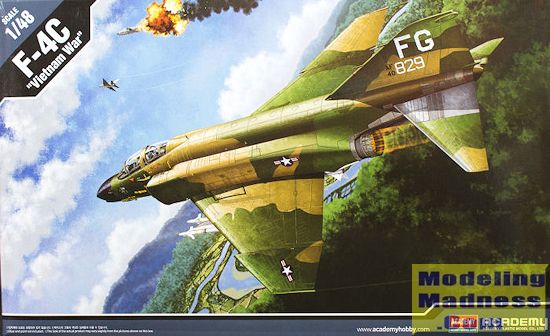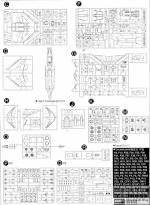
Academy 1/48 F-4C Phantom II
| KIT #: | 12294 |
| PRICE: | $75.00 SRP |
| DECALS: | One option |
| REVIEWER: | Scott Van Aken |
| NOTES: | 2013 tooling |

| HISTORY |
In another part of the Pentagon, the US Navy was very pleased with its new fleet defense fighter. The F4H-1 was turning into a world beater. It was fast, had two engine reliability, and carried a respectable payload. It was breaking speed and altitude records left and right. It was also the Navy's first fighter that did not have a gun, having a weapons load of Sparrows and Sidewinders instead.
Despite the relatively intense rivalry between the USAF and USN, it was pretty obvious to USAF brass that the Navy had the fighter bomber that the Air Force needed and it was available now. Swallowing their jealousy and pride, the USAF decided to adopt the Navy's F4H as their next fighter, the F-110. Of course, they required some changes. Some of it was avionics and some was structural as they needed to add rear cockpit controls and they wanted beefier wheels for use on runways instead of the very high pressure tires used for carriers. This added some bulges to the upper wings and gear doors, but in most all other respects, it was a Navy plane and most parts were interchangeable between the two. By the time the plane entered service, there was a combination of USAF and USN designations with the Navy plane being the F-4B and the USAF version the F-4C. The USAF initially got pilots and maintenance guys up to speed by borrowing 36 F-4Bs until their F-4Cs became available and it was with these planes that the Air Force took the Phantom to war.
Interestingly, the USAF never upgraded
their extant F-4Cs. The Navy did, turning most of their F-4Bs into the
F-4N, an aircraft with improved avionics and engines. However, F-4Cs lasted
longer as they had some remaining in ANG service until the late 1980s, long
after the F-4Bs were out of the fleet or converted.
| THE KIT |
 When
Academy announced a new line of 1/48 Phantom kits in 2013, Phantom phans became
very excited at the prospect of seeing these new kits. After all, the kings at
the time were the Hasegawa kits, which were basically designed in the early
1980s and while still great kits, were lacking in detail in some regards. In
2014, the F-4B was released and eagerly snapped up by modelers. This was
followed by this kit and for the home economy, an F-4D. I'm sure a whole line of
Phantoms will eventually be kitted as this kit has a lot of 'spares'.
When
Academy announced a new line of 1/48 Phantom kits in 2013, Phantom phans became
very excited at the prospect of seeing these new kits. After all, the kings at
the time were the Hasegawa kits, which were basically designed in the early
1980s and while still great kits, were lacking in detail in some regards. In
2014, the F-4B was released and eagerly snapped up by modelers. This was
followed by this kit and for the home economy, an F-4D. I'm sure a whole line of
Phantoms will eventually be kitted as this kit has a lot of 'spares'.
You have probably noticed that MM is rarely the first place to preview kits. To be honest, it just is not a priority to be first. It just doesn't fit the tone of the web site. Once one gets past sticker shock and gets the kit home, opening the box reveals a lot of sprues, several of them duplicates. The different colors of the plastic (white, grey and black) are also a bit odd and there seems no rhyme or reason for the white or black plastic.
So, on to what is in the box, and I should mention that I've not seen this kit before nor read any previous reviews. I do this to maintain objectivity as much as not having the time! The cockpit is quite complete and includes inserts for the instrument side consoles, something I assume is done to allow the USN and other versions to be done. The kit does not offer decals for the instruments, something I like but others are ambivalent about. Seats are nicely done and consist of eight parts. No belts are provided, though you do get crew figures.
The instructions go almost immediately into building up the landing gear bays, each bay consisting of at least four separate walls. It then has you install the gear into these bays, correctly showing a slightly inward cant to the main gear. From what I see, this is an open invitation to break the landing gear while building the kit and makes it so much more difficult to mask when painting the underside. Anyway, we then go to assembling the wings and this is pretty straight-forward stuff. The kit provides separate outer ailerons/flaps. Speed brakes are also separate as they often bleed down once power is removed.
A full intake is offered and though it will be difficult to remove the seams, they are off to the inside so may not be all that noticeable when done. These fit into the lower fuselage section and the upper bit is placed atop it, trapping the intake ducts and the exhaust bits which have to be assembled and installed prior to this. The exhaust assembly also includes the inner lower rear fuselage section between the burner cans. Personally, I would see if the burner cans can be glued in after the fuselage is together, again because masking these to paint around them will be a real pain if not. The intakes themselves are just like every other F-4 kit I've built. the lower aft fuselage, which is most of the unpainted area aft of the exhaust, is separate and in a different color plastic from the rest of the fuselage. But that shouldn't be too surprising as the separate fin and stabilizers are also a different shade.
You get both slotted and unslotted stabilizers to use and
Vietnam era F-4Cs generally used unslotted ones. Actually, I'm not sure if the
slotted ones were ever retrofitted to the F-4C as none of the many slides I have
of this version shows it with them. You also get separate fin tips and rudder
along with separate ou ter
wing sections, though these cannot be modeled raised. Main wheels are in four
parts with two pieces for the hub and two for the tire. I did notice that the
gear doors have large attachment points on them, something that I like to see as
most of the time you have to butt fit the doors. I should also mention that the
IR seeker for under the nose is separate and it looks like an F-4D seeker is
provided in the 'do not use' list so you could do a D version if you so wished.
ter
wing sections, though these cannot be modeled raised. Main wheels are in four
parts with two pieces for the hub and two for the tire. I did notice that the
gear doors have large attachment points on them, something that I like to see as
most of the time you have to butt fit the doors. I should also mention that the
IR seeker for under the nose is separate and it looks like an F-4D seeker is
provided in the 'do not use' list so you could do a D version if you so wished.
Several sprues are dedicated to weapons and pylons. You only get the USAF rounded versions, along with Sidewinder rails and both a MER and TERs. Naturally, these are multiple pieces with a single TER being five pieces. The wing pylons show flare/chaff dispensers. Do not install these as they are incorrect for the kit boxing. I don't even think they were added to F-4Cs and F-4Ds later in life. Other bits are multi-piece Sidewinders and Sparrows, and Mk 80 series slick bombs, all of them with separate fins to attach. A proper early centerline tank and wing tanks are also provided. The canopy is in several sections and a boarding ladder can be installed if one wishes.
Academy's instructions are the map type that are similar to what Dragon and others use. The construction steps are well drawn with some detail images to be sure things are properly aligned. There is a large color chart on the front with the paints from a number of brands provided. What is really surprising is that there is only one markings option and that is for Robin Olds' Scat XXVII. The actual unique markings are on a comparatively tiny decal sheet, while a huge sheet is provided for stencils and markings for the weapons. There is a separate and very large full color painting and markings guide with an equally large one for stencil placement. The decals are nicely printed and while the white and yellow markings seem to disappear into the backing, if the build-up images are any indication, they will be properly opaque.
| CONCLUSIONS |
With all the parts in this kit, it almost makes the Hasegawa offering look like a snap tite! No need to buy aftermarket weapons with this one and you do get a lot of detail with the kit. I'll have to gig Academy for being so stingy on the decals as a kit of this cost should have multiple options right in the box. Overall I would say that you shouldn't toss your Hasegawa Phantoms as they are still quite nice kits. This one is just that much nicer, but you'll be paying a premium for that niceness.
As an afterthought, I was wondering if this kit was overpriced at $75.00. So what I did was find a website that allows you to adjust a price for inflation. Back in 1980 when the Hasegawa 1/48 F-4 kits were first released, they were about $20.00 retail. Adjusted for inflation that would be around $56.00. So doing a reverse of that, the $75.00 today for the Academy kit would equal around $26.00. Not sure if this means anything, but it is an interesting exercise.
February 2015
Thanks to store credit for this one. If you would like your product reviewed fairly and fairly quickly, please contact the editor or see other details in the Note to Contributors.